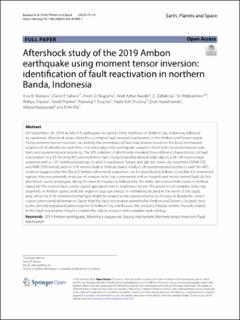| dc.contributor.author | Baskara, Aria W. | |
| dc.contributor.author | Sahara, David P. | |
| dc.contributor.author | Nugraha, Andri D. | |
| dc.contributor.author | Rusdin, Andi Azhar | |
| dc.contributor.author | Zulfakriza, Z. | |
| dc.contributor.author | Widiyantoro, Sri | |
| dc.contributor.author | Triyoso, Wahyu | |
| dc.contributor.author | Priyono, Awali | |
| dc.contributor.author | Puspito, Nanang T. | |
| dc.contributor.author | Shiddiqi, Hasbi Ash | |
| dc.contributor.author | Kusumawati, Dian | |
| dc.contributor.author | Rudyawan, Alfend | |
| dc.contributor.author | Elly, Erfin | |
| dc.date.accessioned | 2023-12-08T12:52:19Z | |
| dc.date.available | 2023-12-08T12:52:19Z | |
| dc.date.created | 2023-10-12T09:35:00Z | |
| dc.date.issued | 2023 | |
| dc.identifier.issn | 1343-8832 | |
| dc.identifier.uri | https://hdl.handle.net/11250/3106637 | |
| dc.description.abstract | On September 26, 2019, an Mw 6.5 earthquake occurred 23 km northeast of Ambon City, Indonesia, followed by numerous aftershock series related to a complex fault network reactivation in the Ambon and Seram region. Using moment tensor inversion, we identify the kinematics of fault reactivation based on the focal mechanism solution of 20 aftershocks with Mw > 3.2 and analyze the earthquake sequence from both focal mechanism solutions and spatiotemporal seismicity. The MTs solution of aftershocks revealed three different characteristics of fault reactivation: (i) a 35 km long N-S oriented main fault characterized by dextral strike-slip (ii) a NE-SW reverse fault segment with a ~ 55° northeastward dip located in southwest Seram, and (iii) two strike-slip segments (NNW-SSE and NNE-SSW trends) and an E-W normal fault in Ambon Island. Analysis of spatiotemporal seismicity with the MTs solution suggests that the Mw 6.5 Ambon aftershock sequences can be described as follows: (i) an Mw 6.5 mainshock rupture that was primarily made up of a major strike-slip component and an insignificant minor normal fault; (ii) first aftershock cluster propagate along the main N-S ruptures, followed by the strike-slip and normal cluster in Ambon Island (iii) The reverse fault events cluster appeared next in Southwest Seram. The presence of complex strike-slip segments in Ambon agrees with the regional structure trends in Halmahera, located in the north of the study area, while the E-W oriented normal fault might be related to the eastward velocity increase in Banda Arc, which causes extensional deformation. Given that the fault reactivation identified in Ambon and Seram is located close to the densely populated urban regions of Ambon City and Kairatu, the analysis of future seismic hazards related to this fault reactivation should consider the risks in a region with complex fault settings. | en_US |
| dc.language.iso | eng | en_US |
| dc.publisher | Springer | en_US |
| dc.rights | Navngivelse 4.0 Internasjonal | * |
| dc.rights.uri | http://creativecommons.org/licenses/by/4.0/deed.no | * |
| dc.title | Aftershock study of the 2019 Ambon earthquake using moment tensor inversion: identification of fault reactivation in northern Banda, Indonesia | en_US |
| dc.type | Journal article | en_US |
| dc.type | Peer reviewed | en_US |
| dc.description.version | publishedVersion | en_US |
| dc.rights.holder | Copyright 2023 The Author(s) | en_US |
| dc.source.articlenumber | 124 | en_US |
| cristin.ispublished | true | |
| cristin.fulltext | original | |
| cristin.qualitycode | 1 | |
| dc.identifier.doi | 10.1186/s40623-023-01860-1 | |
| dc.identifier.cristin | 2183998 | |
| dc.source.journal | Earth Planets and Space | en_US |
| dc.identifier.citation | Earth Planets and Space. 2023, 75 (1), 124. | en_US |
| dc.source.volume | 75 | en_US |
| dc.source.issue | 1 | en_US |

